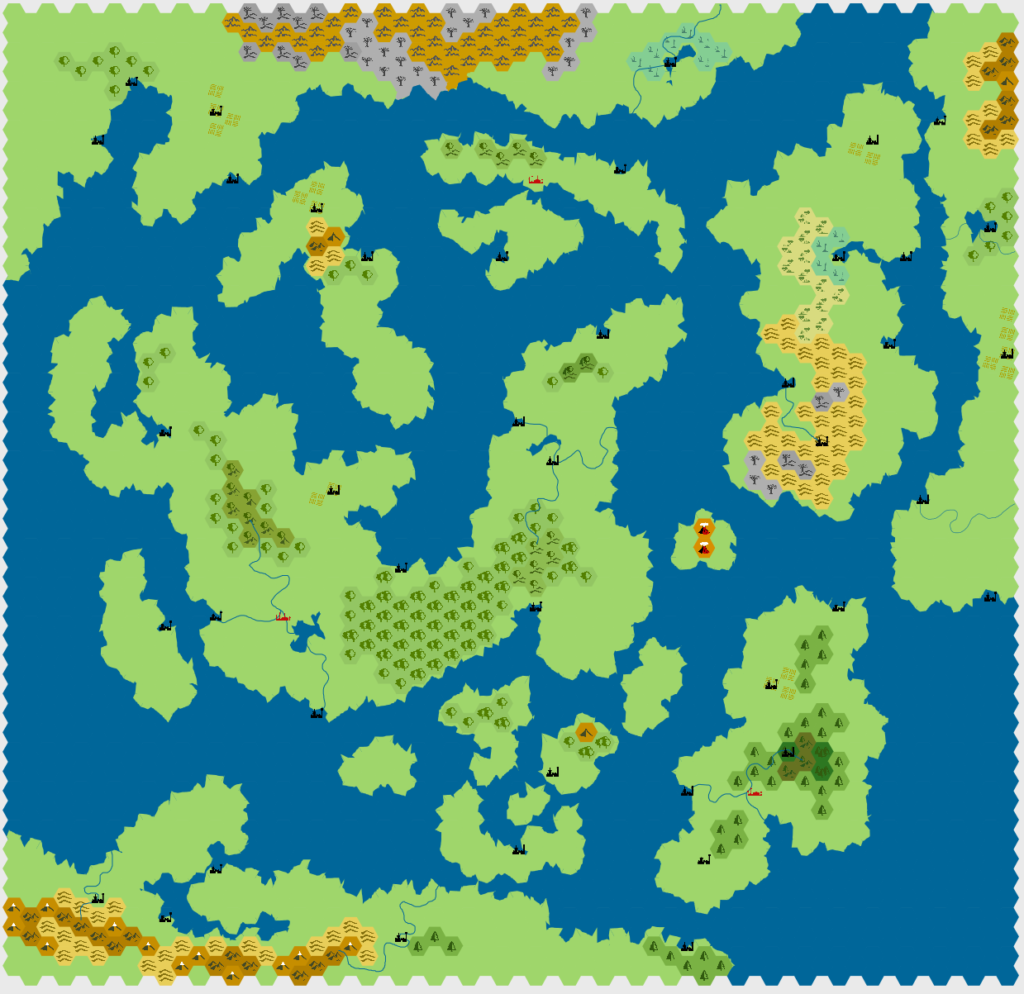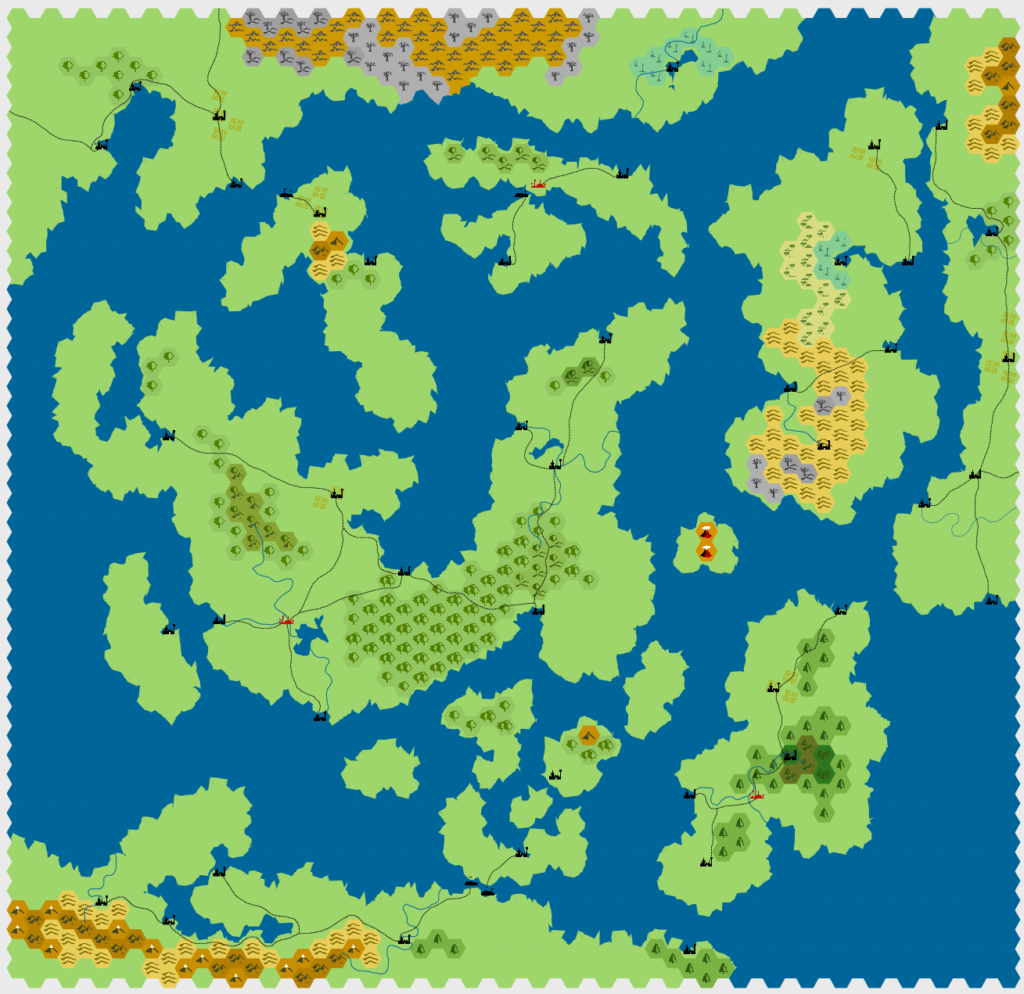Like all of the advice in Worlds Without Number, the stuff about cities gets straight to the point: put the capital in the center of the best arable land, on water; put other cities on water, and near resources; if you stick one in the middle of nowhere, assume there’s a kingdom-level water source not visible on the region-level map. Given that this slice of Dormiir is all islands and water, I figured most cities would be coastal.
Because of the cool natural-looking coastlines I’ve generated in Worldographer, a lot of my cities look like they’re floating in the ocean. But on a zoomed-in, kingdom-level map, they’d be placed in a sub-hex that’s on land.
Per yesterday’s post about population figures, I might reduce the number of cities a bit — but for now, here’s the current state of the Unlucky Isles.

Next up is roads! Once I get my cities stitched together, I’ll have a better feel for how much wilderness is present in each kingdom (and where those wild places are).

I tried to tell some basic stories with my road placement. Brundir is prosperous, populous, and the regional powerhouse: lots of roads, and the capital city is a true hub. The western edge of the Arkestran Dominion, and Kadavis proper, are also pretty well linked-up. Meskmur has sorcery and political isolation in its favor, so they’ve got roads galore.
But Rasu Miar (the island just off the coast of Kadavis, in the east) is sparsely settled and a pretty crappy place to live, so they don’t have a robust road network. And Ahlsheyan is a bit of a mix, with some logical connections missing — because those dwarves love to sail, so some overland trade routes just never really developed.
And looking at the current state of the map, I have to say that I’m not especially worried about reducing the number of cities — because there are tons of areas that aren’t even within a hex of a city or road. Even Brundir, where fully a third of the islefolk live, has lots of areas within its borders that could be wild, lawless, and dangerous.
What’s next?
Looking ahead, I’m now in a good spot to finish answering the rest of the questions in WWN’s “The Region” section: historical events for all six nations, their relationships with one another, and — optionally, but I’ll probably do it — assigning every kingdom its faction statistics. For folks who might be reading this and thinking that the amount of work I’ve already done is at odds with the “get to play quickly, but with a meaningful foundation for your setting” approach WWN advocates…you’re right!
I could easily have skipped several enjoyable hours of figuring out population sizes, placing cities, adding roads, and twiddling the terrain to suit — and instead just finished the rest of the region questions, picked Brundir as my starting kingdom, and moved on to answering the kingdom questions. Hell, I could have skipped making an actual map and just sketched out some vaguely island- and kingdom-shaped outlines on a piece of paper (as WWN suggests in the early stages).
But my goal isn’t to get to play quickly, or even in the medium term — it’s to create My World, one that I’ll be excited to continue to develop for a long time to come.
I might use WWN to gin up Brundir in more detail and then start a fresh map one “block” to the north, covering the Arkestran Dominion — and leave the rest of the Unlucky Isles exactly as they are at the end of “The Region” process. Or I might fully develop each kingdom in the Isles, and the sub-hex around a likely campaign start point in Brundir, so this whole region is richly developed and ready for play. I’m going where the wind takes me, doing whatever moves me.
Worlds Without Number is providing structure, keeping me on track so that I don’t drift off into stuff that won’t ever matter in play. It’s the tool I’m using to ensure a solid foundation for the Isles, and for expanding my worldbuilding to encompass other regions of Dormiir. I want to create a useful, gameable setting full of useful, gameable information — and devoid of cruft, wordy prose, or other stuff that often clogs up published settings. So far, WWN is perfect for that.
(This post is one of a series about worldbuilding with Worlds Without Number.)

I’m very much enjoying these posts and the world that’s emerging. WWN sounds like a good and useful structure. At the very beginning of quarantine I also got a map-building bug… but I got over mine. I think you’ve picked a better set of guides and tools — I really like the simplicity of your map. (I struggled against mine, which seemed like a terrible premonition of frustration with tools if I then pivoted to running the world online.)
Thanks, Scott! I’m glad you’re enjoying my Godsbarrow posts. They’ve been a lot of fun to work on so far.
I usually get lost, then frustrated, then distracted whenever I make a setting map. Not always all three, I guess, but usually one is enough to make me go SQUIRREL! and move on to another project.
WWN is the sort of structure I need. I trust Crawford’s advice because he’s steered me in good directions in past books, and I trust myself to do something interesting inside those soft constraints.